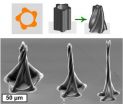(Press-News.org) Flexible circuits can be found in many devices where space and weight considerations are dominant in the design of electronics: in cars, in cameras and video equipment, in mini-computers for athletes or in inkjet printers. And the market continues to grow: according to the business consultancy Frost & Sullivan, sales in this area will grow to more than $16 billion by the year 2014.
At K 2010, the trade fair for plastics in Düsseldorf, Germany, scientists from the IST in Braunschweig will unveil a new reel-to-reel technology for the production of flexible circuits and biosensors; the new technology is known as »P3T«, which is shorthand for »Plasma Printing and Packaging Technology«. The benefits: P3T involves considerably fewer process steps than existing processes, and it conserves raw materials. Unlike previous methods, the researchers do not start with a polymer film metalized over its entire surface from which excess metal is then removed to create the circuits. Instead, to produce flexible circuit boards, they apply circuits made of copper to the film that serves as substrate. In the case of biosensors, palladium is used. They use plasma at atmospheric pressure and galvanization instead of vacuum-pressure and laser-based methods to achieve inexpensive and resource-efficient production.
Dr. Michael Thomas, director of the research group at IST, explains: »During production of circuits for an RFID antenna, you often have to etch away between 50 and 80 percent of the copper used. This results in considerable amounts of copper scrap that either has to be disposed or reprocessed using relatively elaborate methods.« The IST approach is different: there, scientists use the additive process to apply the structures they want directly to the substrate sheeting.
The first two process steps are plasma printing at atmospheric pressure and metallization using well-known galvanization methods. Plasma printing uses the kind of deeply engraved roller familiar from the area of conventional rotogravure printing. During the printing process, microplasms are electrically generated in the engraved recesses of the roller; these microplasms chemically alter the surface of the plastic substrate where the circuits are to be applied later in the process.
The process gas from which the plasma is created is usually a mixture of nitrogenous gases. As IST researcher Thomas emphasizes: »The chemical changes we need begin to form on the surface of the film; these changes ensure that the plastic can be wetted with water in these precise areas and will be metallizable using suitable plating baths. This means considerable savings of energy and material,« Thomas adds. And this is a decisive competitive factor: the prices for raw materials – for copper and palladium, for example – have risen by around 150 percent in the past three years.
In the joint P3T project sponsored by the German Federal Ministry of Education and Research (BMBF) P3T, researchers are currently working very hard to improve the individual processes involved in the manufacture of flexible circuit boards and biosensors. They are closely scrutinizing all of the P3T production steps – from plasma printing to assembly and coordinating all of the processes with one another in a production line.
INFORMATION:
Conserving resources: Producing circuit boards with plasma
2010-10-20
ELSE PRESS RELEASES FROM THIS DATE:
Consumer sentiment shaped by differing cultural attitudes toward power
2010-10-20
CHAMPAIGN, Ill. – In the battle of egos, Donald Trump vs. Hugo Chavez might be a draw. But as symbols of power, each resonates differently with different cultures, as cultures nurture different views of what is desirable and meaningful to do with power, according to new research by a University of Illinois marketing expert.
Sharon Shavitt says the relation between culture and one's concepts of power emerge from one's cultural orientation, and how that culture shapes one's beliefs, attitudes and goals.
"People's views of powerful people and what powerful people are supposed ...
Bacteria gauge cold with molecular measuring stick
2010-10-20
HOUSTON -- (Oct. 19, 2010) -- Some bacteria react to the cold by subtly changing the chemistry of their outer wall so that it remains pliable as temperatures drop. Scientists identified a key protein in this response mechanism a few years ago, but the question of how bacteria sense cold in the first place remained a mystery. Based on a study by scientists at Rice University and Argentina's National University of Rosario, the answer is: They use a measuring stick.
The study, published in the September issue of Current Biology, involved a series of intricate experiments ...
Osteoporosis drug builds bone in patients with gum disease
2010-10-20
ANN ARBOR, Mich.---A drug marketed to grow bone in osteoporosis patients also works to heal bone wounds in gum disease patients, a University of Michigan study suggests.
"This new approach for the treatment of periodontal disease could allow us to rebuild some of the bone that is lost due to periodontal disease, which until this point has been very difficult to achieve," said Jill Bashutski, clinical assistant professor at the U-M School of Dentistry and first author on the study. "Current treatments to re-grow bone around teeth affected with gum disease have limited ...
A middle class that copes by shopping secondhand
2010-10-20
Conventional wisdom holds that people try to mimic the behavior of the next social class above their own.
Except when it comes to shopping at secondhand stores and yard sales, concludes a new study by Brigham Young University sociology students and faculty.
The study found that high-income shoppers scour the secondhand market for antiques, but everyone else is trying to stretch the family dollar.
"Middle-class shoppers were looking for furniture, some appliances, clothes, things that you could argue are necessities," said BYU sociology professor Ralph Brown. "There's ...
UT professor defines play, discovers even turtles need recess
2010-10-20
Seeing a child or a dog play is not a foreign sight. But what about a turtle or even a wasp?
Apparently, they play, too.
In fact, according to Gordon Burghardt, a psychology professor at the University of Tennessee, Knoxville, many animals -- not just dogs, cats, and monkeys -- need a little play time.
"I studied the behavior of baby and juvenile reptiles for many years and never saw anything that I thought was play. Then I had an epiphany when I saw Pigface, a Nile softshell turtle, batting around a basketball at the National Zoo in Washington, D.C. I realized ...
New clinical trial explores role of vitamin D in preventing esophageal cancer
2010-10-20
CLEVELAND – In a first-of-its-kind clinical trial, physicians at University Hospitals (UH) Case Medical Center who are Case Western Reserve University School of Medicine researchers are exploring the role of Vitamin D in preventing esophageal cancer. Principal Investigator Linda Cummings, MD, along with Amitabh Chak, MD, and Gregory Cooper, MD, from the UH Digestive Health Institute, is recruiting patients with Barrett's esophagus to measure the effects of Vitamin D on protein levels that may influence the risk of developing esophageal cancer.
"Vitamin D is being studied ...
Intricate, curving 3-D nanostructures created using capillary action forces
2010-10-20
ANN ARBOR, Mich.---Twisting spires, concentric rings, and gracefully bending petals are a few of the new three-dimensional shapes that University of Michigan engineers can make from carbon nanotubes using a new manufacturing process.
The process is called "capillary forming," and it takes advantage of capillary action, the phenomenon at work when liquids seem to defy gravity and travel up a drinking straw of their own accord.
The new miniature shapes, which are difficult if not impossible to build using any material, have the potential to harness the exceptional mechanical, ...
Gene activity in the brain depends on genetic background
2010-10-20
SEATTLE, Wash.—October 18, 2010—Researchers at the Allen Institute for Brain Science have found that the same genes have different activity patterns in the brain in individuals with different genetic backgrounds. These findings may help to explain individual differences in the effectiveness and side-effect profiles of therapeutic drugs and thus have implications for personalized medicine. The study is available in this week's online early edition of the Proceedings of the National Academy of Sciences (www.pnas.org).
In this study, the authors compared where in the brain ...
See no shape, touch no shape, hear a shape?
2010-10-20
Scientists at The Montreal Neurological Institute and Hospital – The Neuro, McGill University have discovered that our brains have the ability to determine the shape of an object simply by processing specially-coded sounds, without any visual or tactile input. Not only does this new research tell us about the plasticity of the brain and how it perceives the world around us, it also provides important new possibilities for aiding those who are blind or with impaired vision.
Shape is an inherent property of objects existing in both vision and touch but not sound. Researchers ...
Sniffing out shoe bombs: A new and simple sensor for explosive chemicals
2010-10-20
CHAMPAIGN, Ill. — University of Illinois chemists have developed a simple sensor to detect an explosive used in shoe bombs. It could lead to inexpensive, easy-to-use devices for luggage and passenger screening at airports and elsewhere.
Triacetone triperoxide (TATP) is a high-powered explosive that in recent years has been used in several bombing attempts. TATP is easy to prepare from readily available components and has been difficult to detect. It defies most standard methods of chemical sensing: It doesn't fluoresce, absorb ultraviolet light or readily ionize.
The ...


